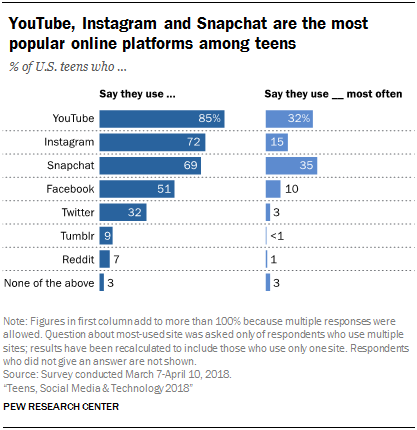most popular programming languages
++++++++++
more on coding in this IMS blog
https://blog.stcloudstate.edu/ims?s=coding
Digital Literacy for St. Cloud State University
++++++++++
more on coding in this IMS blog
https://blog.stcloudstate.edu/ims?s=coding
October 14, 2019, Robin Young Allison Hagan
https://www.wbur.org/hereandnow/2019/10/14/climate-change-naomi-klein-on-fire
In her new book “On Fire: The Burning Case for a Green New Deal,” Klein writes that allegiance to capitalism is at the heart of climate denial.
In higher education, 29.7% of all students are taking at least one distance course.
The total distance enrollments are composed of 14.3% of students (2,902,756)
taking exclusively distance courses and 15.4% (3,119,349) who are taking a
combination of distance and non-distance courses. The vast majority (4,999,112,
or 83.0%) of distance students are studying at the undergraduate level.
Almost half of the distance education students are concentrated in just five percent of the institutions, while the top 47 institutions, only 1.0% of the total, enroll 23.0% (1,385,307) of all distance students.
The total number of students studying on campus (those not taking any distance course or taking a combination of distance and non-distance courses) dropped by almost one million (931,317) between 2012 and 2015. The largest declines came at for-profit institutions, which saw a 31.4% drop, followed by 2-year public institutions, which saw a 10.4% decrease.
++++++++++++
https://www.bestcolleges.com/perspectives/annual-trends-in-online-education/
69% of online students identified employment as their primary goal for entering a program. 17% are grad students.
Seventy percent of administrators said they launch new programs with enrollment growth in mind, while meeting marketing and recruitment goals was their top concern.
++++++++++++
https://www.bestcolleges.com/perspectives/annual-student-guide-to-online-education/
++++++++++++++++
https://www.insidehighered.com/news/survey/survey-faculty-attitudes-technology
++++++++++
more on distance education in this IMS blog
https://blog.stcloudstate.edu/ims?s=distance+education
You can view clips from last week & sign up to join us Oct 19 at https://t.co/nC6HKCtdss. See you Saturday in #VR for an unforgettable learning experience! icymi @laura_mcbain @kwaku1 @stevensato @jelimad @oculus @htcvive @JaimeDonally @Rdene915 @teach42 @steve_bambury #ARVRinEDU https://t.co/Nmm8np5OPp
— Caitlin Krause #MindfulByDesign (@MindWise_CK) October 17, 2019
Access awe-inspiring wellbeing and imagination with Caitlin Krause as guide
+++++++++
more on quantum computing in this IMS blog
https://blog.stcloudstate.edu/ims?s=quantum
The best intro to Augmented Reality may be the MergeCube: https://mergevr.com/cube
In 45 min, Mark Gill with the SCSU Vizlab (https://www.facebook.com/SCSUVizLab/), Alan Srock (Astronomy), and Plamen Miltenoff with InforMedia Services (https://www.facebook.com/InforMediaServices/) will guide you through ideas and hands-on setup of the MergeCube in your lesson plans.
When: October 22, 11AM
Where: Miller Center 205 (“how to get” directions here: https://youtu.be/jjpLR3FnBLI )
or join us via Zoom: https://minnstate.zoom.us/my/mergecube
Who: faculty, staff, students interested in exciting new educational technology
Here is more information about the ed use of MergeCube:
https://youtu.be/Agb3N6B8jHM
https://youtu.be/LRbn79WQEVU
https://youtu.be/OeTUIVhhAXY
My note: 17 years after, and several generations after (Millennials, Gen Z) the observations still hold
Singer, M. (2002, February 13). Teaching the MTV Learner. The Chronicle of Higher Education. Retrieved from https://www.chronicle.com/article/Teaching-the-MTV-Learner/46241
Britney Spears does have more appeal than most quadratic equations. With thousands of dollars of high-tech digital engineering spent on every word uttered, or in this case, sung, how can the typical college professor compete?
“In China today, Bill Gates is Britney Spears. In America today, Britney Spears is Britney Spears-and that is our problem.” ― The World Is Flat: A Brief History of the Twenty-first Century https://www.goodreads.com/quotes/304461-in-china-today-bill-gates-is-britney-spears-in-america
MTV Learners are seeking warp-speed answers to their life issues. They want to know: “What does this information (your course) have to do with me (self-actualization)?” and “What does this information (your course) have to do with my career (my choice of vocation)?”
Be democratic, not autocratic. Instead of management by fiat, try taking regular opinion polls and surveys of your students to determine the specific methods of teaching your course.
Try to eliminate the lecture-test, lecture-test, lecture-test format and substitute other learning models that accentuate the choices of the MTV Learner. Focus on the quality of your syllabus as a giant “master operating agreement” that presents the learning objectives of your course and related policies in a manner that is as clear and as easy to understand as possible. Without sounding too litigious on your syllabus, present the consequences of missed absences, overdue work, incomplete assignments, and the like.
Michael Niehoff October 2, 2019
https://www.iste.org/explore/Digital-citizenship/9-ways-real-students-use-social-media-for-good
+++++++++++++
more about social media in education in this IMS blog
https://blog.stcloudstate.edu/ims?s=social+media+education
Young people may be expert social-media and smartphone users, but many lack the digital skills they need for today’s jobs. How can we set them up for success?
https://www.theatlantic.com/sponsored/grow-google-2019/smartphone-generation-computer-help/3127/
Kenneth Cole’s classroom at the Boys & Girls Club of Dane County, located on a quiet residential street in Madison, Wisconsin.
The classes Cole teaches use Grow with Google’s Applied Digital Skills online curriculum.
One day he may lead Club members in a lesson on building digital resumes that can be customized quickly and make job-seeking easier when applying online. Another day they may create a blog. On this particular day, they drew up a budget for an upcoming event using a spreadsheet. For kids who are often glued to their smartphones, these types of digital tasks, surprisingly, can be new experiences.
The vast majority of young Americans have access to a smartphone, and nearly half say they are online “almost constantly.”

But although smartphones can be powerful learning tools when applied productively, these reports of hyperconnectivity and technological proficiency mask a deeper paucity of digital skills. This often-overlooked phenomenon is limiting some young people’s ability—particularly those in rural and low-income communities—to succeed in school and the workplace, where digital skills are increasingly required to collaborate effectively and complete everyday tasks.
According to a survey by Pew Research Center, only 17 percent of Americans are “digitally ready”—that is, confident using digital tools for learning. Meanwhile, in a separate study, American millennials ranked last among a group of their international peers when it came to “problem-solving in technology-rich environments,” such as sending and saving digital information
teach his sophomore pupils the technology skills they need in the workplace, as well as soft skills like teamwork.
+++++++++++++++++++++
more on digitally native in this IMS blog
https://blog.stcloudstate.edu/ims?s=digitally+native
more on millennials in this IMS blog
https://blog.stcloudstate.edu/ims?s=millennials